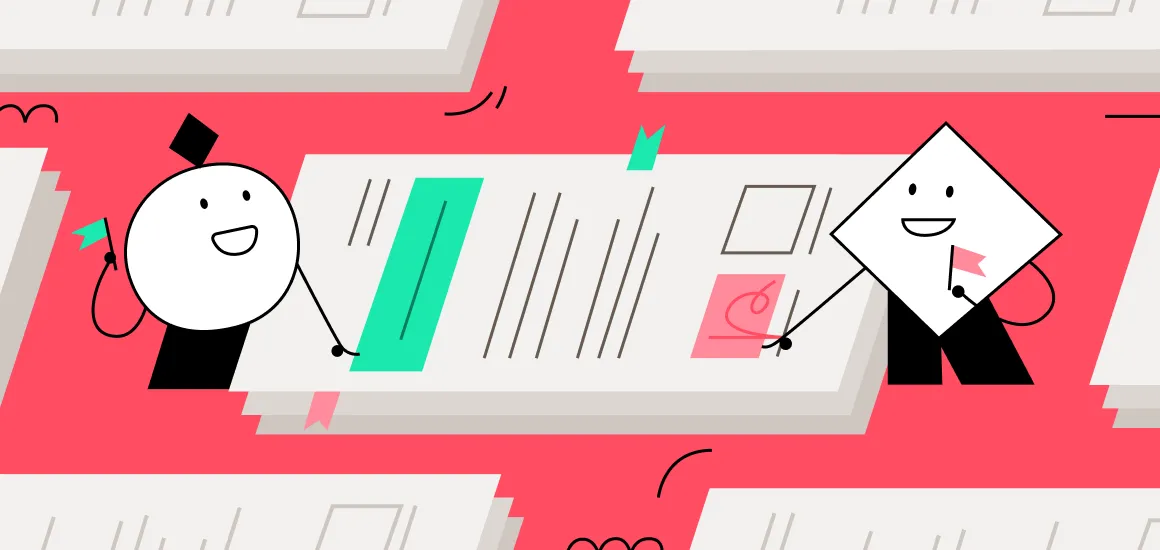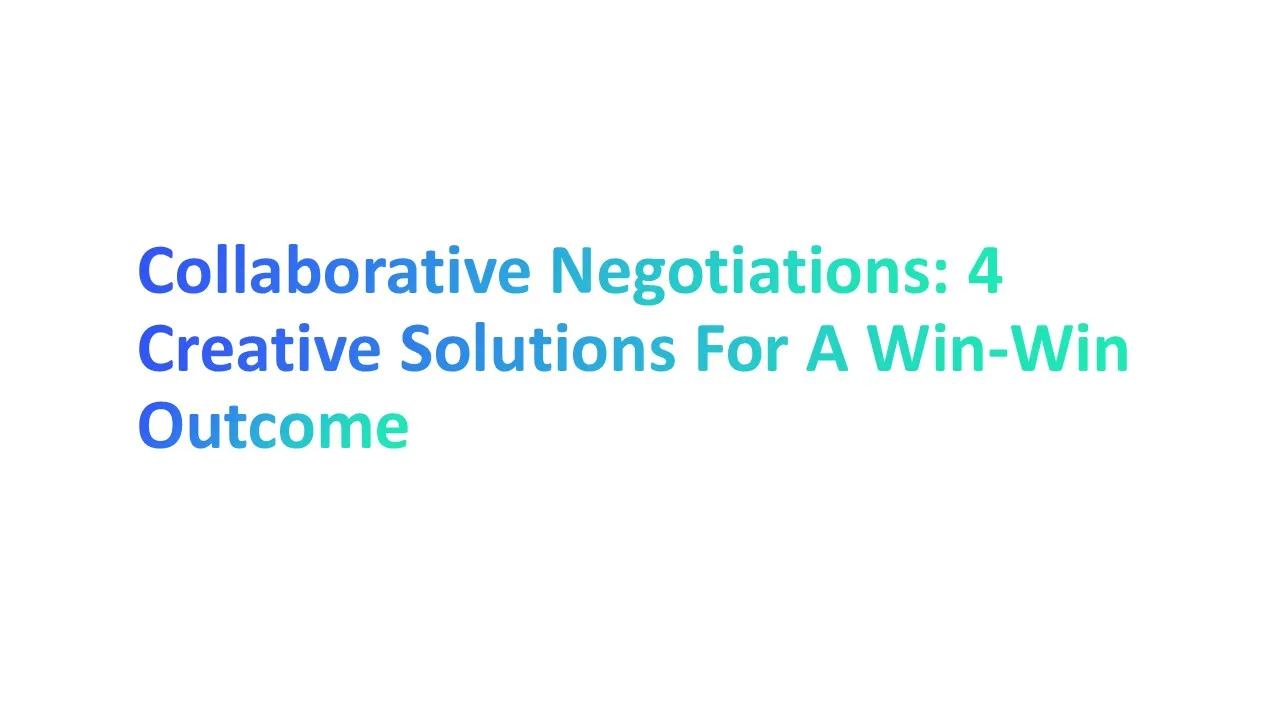Collaborative negotiations are more important than ever, with studies showing that over 80% of successful business deals stem from win-win outcomes (Harvard Business Review).
In this article, you'll discover practical, creative and innovative solutions to make your negotiations more effective.
Collaborative negotiation is when two or more parties work together to reach a win-win outcome. Instead of competing, they focus on solving problems together.
The goal is a mutually beneficial agreement, where everyone feels satisfied. This type of collaborative negotiation requires building trust in relationships.
A win-win situation means both parties leave the negotiation feeling like they have gained something valuable.
In the negotiation process, both sides cooperate to do a joint problem solving and find creative solutions that work for everyone involved.
Why is Collaborative Negotiation Important?
- Builds Positive Relationships: In collaborative negotiations, both parties work together, which helps maintain long-term partnerships. By focusing on mutual benefits, it strengthens trust and creates a sense of cooperation that leads to future opportunities.
- Encourages Open Communication: In collaborative negotiation, open communication is key. Both parties share their needs, interests, and concerns, which makes it easier to find solutions that work for everyone. It reduces misunderstandings and fosters transparency.
- Supports Creative Problem-Solving: Collaborative negotiation encourages both sides to find creative solutions.
- Instead of just focusing on individual goals, they work together to come up with ideas that can benefit everyone involved. This leads to better outcomes and more innovative agreements.
Solutions to Achieve a Mutually Beneficial Agreement

1. Expand the Pie Before Splitting It
Collaborative negotiations aim to find creative solutions that work for both parties. Expanding the pie means increasing the total value of what's being negotiated. Instead of dividing the existing resources, you look for ways to add more value.
Why is it important:
By expanding the pie, both parties gain more, reducing conflict. Studies show that negotiations where both parties focus on expanding value lead to long-term partnerships and increased trust (Harvard Business Review).
How to implement:
- Understand the interests: Ask questions to uncover the needs and interests of the other party.
- Explore new options: Think of creative solutions, like bundling services or offering additional products, to increase the value available.
- Collaborate on solutions: Work together to find options that benefit both sides.
This collaborative approach helps you reach a negotiated agreement that works for everyone and promotes a win-win outcome.
2. Leverage Trade-offs on Low-Priority Issues
Not every issue in negotiations carries equal weight. Some are critical, while others are less important. Leveraging trade-offs on low-priority issues means making concessions on things that matter less to you in exchange for something more valuable.
Why is it important:
Trade-offs help reduce conflict and speed up the negotiation process. Research shows that 68% of successful negotiations involve some form of trade-offs on less important matters (Negotiation Experts, 2021). This allows both parties to walk away feeling satisfied.
How to implement:
- Identify priorities: Make a list of what’s most and least important to you.
- Offer flexibility: Be willing to give in on low-priority issues, like delivery dates or payment terms, in exchange for more important wins.
- Ask the other party: Encourage the other side to share their priorities, so both sides can focus on high-value areas.
This method ensures that both parties feel they’ve reached a mutually beneficial agreement without compromising on core issues.
3. Create Contingency Agreements
In collaborative negotiations, creating contingency agreements is a smart way to manage uncertainty. A contingency agreement is a backup plan both parties agree on if things don’t go as expected.
For example, if a project’s timeline is delayed, a contingency agreement could define how to adjust deadlines or costs.
Why is it important:
Contingency agreements reduce risks for both parties. They help build trust and avoid conflicts down the road. If something changes, you already have a plan that everyone agrees on.
According to negotiation experts, around 50% of successful business deals use contingency agreements to address unexpected issues.
How to implement:
- Identify risks: Both parties should discuss what could go wrong, like delivery delays or changes in cost.
- Agree on solutions: Set clear guidelines for how to handle each risk.
- Write it down: Make sure the contingency agreement is part of the main negotiated agreement so there’s no confusion later.
This way, both sides feel protected and other parties are more likely to reach a mutually beneficial outcome.
4. Use Objective Criteria for Fair Solutions
When two or more parties are negotiating, it’s important to rely on objective criteria to make decisions. Objective criteria are facts, data, or standards that everyone agrees on.
For example, if you’re negotiating a price, you might use market value or industry standards to decide what’s fair.
Why is it important:
Using objective criteria keeps negotiations fair and prevents arguments. It removes emotions from the conversation and focuses on facts.
A study by Harvard Law School shows that negotiations using objective criteria lead to better long-term relationships.
How to implement:
- Research the facts: Look for data that both parties trust, like market prices or expert recommendations.
- Agree on the standard: Both sides should agree to use the same objective criteria to guide the conversation.
- Stick to the facts: When discussing terms, refer back to the data instead of personal preferences.
By following this approach, you can avoid unnecessary conflicts and ensure a win-win outcome that satisfies everyone.
Adversarial negotiations Vs Collaborative negotiation

What is Adversarial Negotiation?
Adversarial negotiation is when two parties compete against each other to win. It often feels like a battle. Each side tries to get as much as they can without caring much about the other party.
For example, imagine two people fighting over the last piece of cake. In an adversarial approach to negotiations, one person will try to grab it all without sharing.
This type of negotiation can create tension and damage relationships. It’s also called a “win-lose” negotiation because one side wins and the other loses.
Key Differences Between Adversarial and Collaborative Negotiations
1.Focus of Each Party:
- In adversarial negotiations, each party is focused on winning for themselves.
- In collaborative negotiations, both parties work together to find creative solutions that benefit everyone.
Different negotiation styles can impact how quickly both parties can reach a mutually beneficial agreement
2.Relationship Impact:
- Adversarial negotiations can harm relationships. After the negotiation, people may not want to work together again.
- Collaborative negotiations build long-term relationships and trust. Both sides are likely to work together again in the future.
3.Communication Style:
- Adversarial negotiators often hide their real interests. They may not be open about their goals, making the process feel secretive.
- In collaborative negotiations, both sides share their goals openly and look for ways to meet the other party’s needs.
4.Outcome:
- In adversarial negotiations, one party walks away feeling like they lost. This can lead to resentment.
- In collaborative negotiations, both parties feel like they gained something, leading to a more positive outcome.
5.Examples in Real Life:
- An example of adversarial negotiation might be a tough salary negotiation where both the employee and employer are unwilling to compromise.
- A collaborative negotiation example could be two businesses forming a partnership. They work together to make sure both sides get what they need.
The Role of Parties Involved in the Negotiation Process

In collaborative negotiations, each party plays an important role in ensuring the success of the negotiation process. The two or more parties involved in interest based negotiation will need to communicate clearly, protect the agreement, and focus on achieving a mutually beneficial outcome.
1. Driving the Communication Framework
The communication framework is how parties talk and share information during negotiations. It’s important for everyone to understand the rules for communication to avoid misunderstandings.
A collaborative negotiation approach is a framework which helps ensure that both parties are clear about their goals, concerns, and expectations.
Why is it important:
Effective communication is key to resolve conflicts and reaching a win-win outcome. When parties communicate openly, they can focus on solving problems together rather than working against each other.
Poor communication can lead to no conflict resolution, mistrust, and even failure to reach a negotiated agreement. Research shows that 80% of successful negotiations involve clear and structured communication (Harvard Business Review).
How to implement it:
- Set clear guidelines: Decide how often you’ll meet, how you’ll share information, and how decisions will be made.
- Use open-ended questions: Encourage the other party to share their interests and needs by asking questions like, "What’s most important to you in this deal?"
- Listen actively: Pay attention to the other party’s concerns and address them directly.
Good communication is the foundation for building and maintaining positive relationships with business partner and achieving a mutually beneficial agreement in the negotiation process.
2. Guardians of the Negotiated Agreement
Once a deal is reached through competitive negotiation, it’s important that both parties follow through on what they’ve agreed upon. This is where the role of “guardians of the agreement” comes in. Each best deal is responsible for ensuring that the terms of the agreement are respected.
Why is it important:
Protecting the agreement is essential for long-term success. If one party doesn’t follow through, it can damage trust and ruin the long-term relationship.
Ensuring both sides stick to the agreement helps build confidence and prevents future conflicts. Studies show that agreements where both sides feel equally responsible are 30% more likely to last (Negotiation Experts).
How to implement it:
- Write everything down: Make sure all the terms of the agreement are clearly written and understood by both parties.
- Assign accountability: Decide who will be responsible for monitoring the agreement and handling any issues that arise.
- Review regularly: Schedule regular check-ins to make sure both sides are sticking to their commitments.
By playing the role of guardians, parties can ensure that the negotiation process results in a lasting and fair mutually beneficial agreement.
Conclusion
Collaborative negotiations offer a powerful way to reach mutually beneficial agreements. By focusing on clear communication and building trust with the other party, both sides can achieve a win-win outcome.
Whether it’s two businesses or individuals, the negotiation process becomes smoother when everyone works together. The key is to create positive relationships that last. Remember, a successful negotiation and collaboration doesn't mean one side wins and the other loses; it means both parties walk away satisfied.








